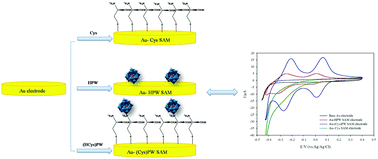当前位置:
X-MOL 学术
›
New J. Chem.
›
论文详情
Our official English website, www.x-mol.net, welcomes your
feedback! (Note: you will need to create a separate account there.)
Electrochemical behavior of inorganic–organic hybrid polyoxometalate ((Cys)3[PW12O40]) nanostructure self-assembled monolayer on polycrystalline gold electrode surfaces†
New Journal of Chemistry ( IF 2.7 ) Pub Date : 2018-12-06 00:00:00 , DOI: 10.1039/c8nj05721d Somayeh Dianat 1, 2, 3 , Abdolhamid Hatefi-Mehrjardi 3, 4, 5, 6, 7 , Kourosh Mahmoodzadeh 3, 4, 5, 6, 7
New Journal of Chemistry ( IF 2.7 ) Pub Date : 2018-12-06 00:00:00 , DOI: 10.1039/c8nj05721d Somayeh Dianat 1, 2, 3 , Abdolhamid Hatefi-Mehrjardi 3, 4, 5, 6, 7 , Kourosh Mahmoodzadeh 3, 4, 5, 6, 7
Affiliation

|
The electrochemistry of polyoxometalates (POMs) is very rich, as many of them can transfer multiple electrons without their structure being changed. In this study, an inorganic–organic hybrid compound, building from H3[PW12O40] (HPW) and L-cysteine (Cys), was prepared by a solvent free reaction and structurally characterized by routine methods. The results showed that HPW preserved its parent structure after functionalization by Cys. Then, (Cys)PW was assembled on a cleaned polycrystalline gold (poly Au) electrode for the first time. The electrochemical behavior of the poly Au-(Cys)PW SAMs-modified electrode was then investigated in detail using cyclic voltammetry (CV). Experimental results showed that the poly Au-(Cys)PW SAMs-modified electrode not only had a higher electrochemical activity than a poly Au-HPW SAMs-modified electrode, but also showed remarkable stability due to greater insolubility of the hybrid POM nanoparticles than the parent POM and a strong covalent bond poly Au–S, which is important for practical applications. Moreover, surface coverage of the different monolayers was determined from linear sweep voltammetry (LSV) data. Cys and (Cys)PW solutions prepared in 0.1 M HClO4 provided coverages of 1.9 ± 0.2 and 2.1 ± 0.2 nmol cm−2 on the poly Au surface, respectively as evaluated from their reductive desorption peaks. The significance of our research is to provide a kind of gold surface modified with the (Cys)PW nanostructure with a higher electrochemical activity and stability and was applied in an electrode modification.
中文翻译:

无机-有机杂多金属氧酸盐((Cys)3 [PW 12 O 40 ])纳米结构自组装单层在多晶金电极表面上的电化学行为†
多金属氧酸盐(POM)的电化学非常丰富,因为它们中的许多可以转移多个电子而不会改变其结构。在这项研究中,一种无机-有机杂化化合物,由H 3 [PW 12 O 40 ](HPW)和L-半胱氨酸(Cys)是通过无溶剂反应制备的,并通过常规方法对其结构进行了表征。结果表明,HPW被Cys官能化后保留了其母体结构。然后,首次将(Cys)PW组装在清洁的多晶金(poly Au)电极上。然后使用循环伏安法(CV)对聚Au-(Cys)PW SAMs修饰电极的电化学行为进行了详细研究。实验结果表明,聚Au-(Cys)PW SAMs修饰电极不仅比聚Au-HPW SAMs修饰电极具有更高的电化学活性,而且由于杂化POM纳米粒子的不溶性也比聚Au-HPW SAMs修饰的电极高,因此显示出显着的稳定性。母体POM和强共价键聚Au-S,这对实际应用很重要。而且,根据线性扫描伏安法(LSV)数据确定不同单层的表面覆盖率。在0.1 M HClO中制备的Cys和(Cys)PW溶液从其还原解吸峰评估,图4提供了在聚Au表面上分别为1.9±0.2和2.1±0.2nmol cm -2的覆盖率。我们研究的意义是提供一种用(Cys)PW纳米结构修饰的金表面,具有较高的电化学活性和稳定性,并用于电极修饰。
更新日期:2018-12-06
中文翻译:

无机-有机杂多金属氧酸盐((Cys)3 [PW 12 O 40 ])纳米结构自组装单层在多晶金电极表面上的电化学行为†
多金属氧酸盐(POM)的电化学非常丰富,因为它们中的许多可以转移多个电子而不会改变其结构。在这项研究中,一种无机-有机杂化化合物,由H 3 [PW 12 O 40 ](HPW)和L-半胱氨酸(Cys)是通过无溶剂反应制备的,并通过常规方法对其结构进行了表征。结果表明,HPW被Cys官能化后保留了其母体结构。然后,首次将(Cys)PW组装在清洁的多晶金(poly Au)电极上。然后使用循环伏安法(CV)对聚Au-(Cys)PW SAMs修饰电极的电化学行为进行了详细研究。实验结果表明,聚Au-(Cys)PW SAMs修饰电极不仅比聚Au-HPW SAMs修饰电极具有更高的电化学活性,而且由于杂化POM纳米粒子的不溶性也比聚Au-HPW SAMs修饰的电极高,因此显示出显着的稳定性。母体POM和强共价键聚Au-S,这对实际应用很重要。而且,根据线性扫描伏安法(LSV)数据确定不同单层的表面覆盖率。在0.1 M HClO中制备的Cys和(Cys)PW溶液从其还原解吸峰评估,图4提供了在聚Au表面上分别为1.9±0.2和2.1±0.2nmol cm -2的覆盖率。我们研究的意义是提供一种用(Cys)PW纳米结构修饰的金表面,具有较高的电化学活性和稳定性,并用于电极修饰。











































 京公网安备 11010802027423号
京公网安备 11010802027423号